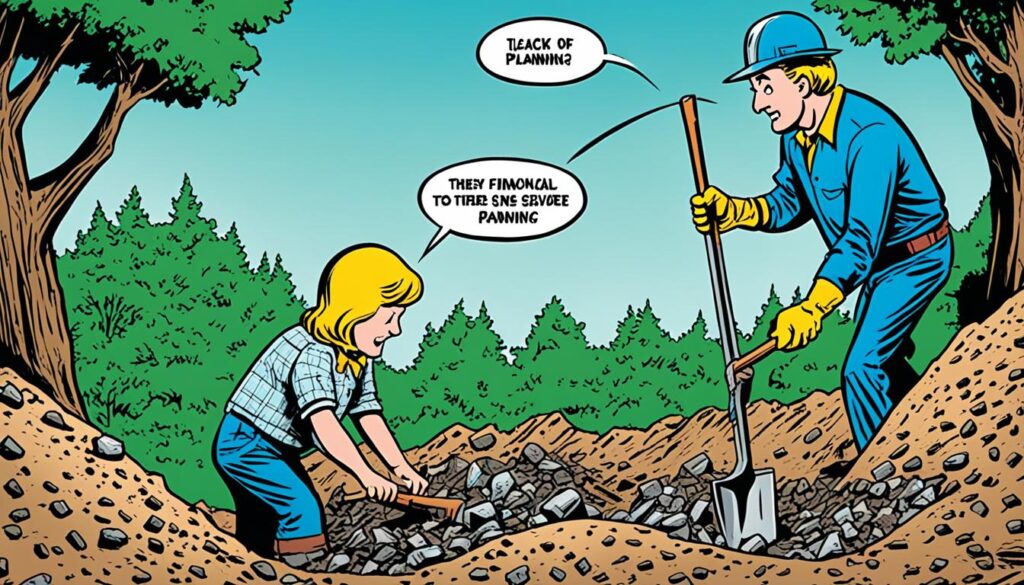Did you know that fewer than 10% of seed-funded startups advance to Series A funding? This statistic highlights the significance of thorough preparation for startup funding in a fiercely competitive environment. Whether you are aspiring to start a business or have recently launched one, understanding the funding stages is essential. Implementing effective strategies can significantly enhance your prospects of securing the necessary capital for your venture.
This guide will show you how to face the startup funding challenge by listing key preparation steps. We’ll cover everything from crafting a detailed business plan to forming a strong team and reaching out to investors. Knowing these strategies helps you to be ready to catch the eye of investors for your startup’s future.
Key Takeaways
- Startup funding preparation is vital for securing necessary capital.
- Understanding funding stages, including pre-seed funding, is essential.
- A solid business plan can improve your investment prospects.
- Networking with potential investors can provide valuable insights and connections.
- Company valuation plays a key role in negotiations with investors.
Understanding Startup Funding Stages
For every entrepreneur, knowing the startup funding stages is key. These stages include pre-seed funding, seed funding, and Series A and beyond. Each step helps a startup grow and reach new milestones.
In the pre-seed stage, entrepreneurs get their initial funds, ranging from $10,000 to $100,000. This money usually comes from personal savings or friends and family. At this point, most startups are valued at about $10,000 to $100,000. This early investment is vital for turning ideas into plans.
Next comes the seed funding stage. Here the goal is to develop the product and start making a name in the market. Seed funding amounts vary, going from a few thousand dollars to several million. Startups are valued between $3 million to $6 million. This fund helps in product development, testing, and initial marketing.
Knowing the differences between these funding rounds is crucial for success. Each stage, like pre-seed and seed, has different investor expectations. At these early stages, investors are more interested in potential than revenue. It’s important for entrepreneurs to understand these stages for effective planning and strategy.
Entering Series A and Series B rounds means seeking larger investments. The funds raised can range from $1 million to $15 million in Series A, with startup values between $10 million to $30 million. Series B pushes valuations and funding even higher, often over $30 million for companies valued up to $60 million.
In brief, understanding startup funding stages, especially pre-seed and seed, is critical. It prepares you to engage with investors and navigate your startup’s early growth.
What is Pre-Seed Funding?
Pre-seed funding is the first money used to get a startup off the ground. It usually ranges from $50,000 to $250,000. This money helps entrepreneurs hire staff, build prototypes, and study the market. Knowing the pre-seed funding definition is key. It prepares the way for future funding rounds that could bring in more money.
Funding at this early stage often comes from friends, family, and initial investors who believe in the idea. Since these startups don’t have much sales data yet, investors look at the team’s potential and drive. Having a good pitch deck is crucial. It should clearly show your product, how your business works, who will buy it, and your financial plans. It’s also wise to pitch to people who’ve invested in similar areas before.
A summary of key characteristics of pre-seed funding is shown in the table below:
| Aspect | Details |
|---|---|
| Funding Amount | $50,000 – $250,000 |
| Typical Investors | Friends, family, angel investors, pre-seed VC firms |
| Use of Funds | Prototype development, hiring, market research |
| Equity Exchange | Investors often receive equity in the company |
| Success Factors | Strong pitch deck, experienced investors, solid business model |

Importance of Pre-Seed Funding
Pre-seed funding is a crucial first step for startups. It helps turn ideas into products that people can actually buy. Usually, it’s between about $50,000 and $250,000. This money comes from angel investors, personal connections, or accelerators. With it, startups can make a basic version of their product, research the market, and get a great team together.
Getting pre-seed funding shows a startup is serious. It not only gets the business off the ground but also connects with future investors. To get ready for bigger funding rounds later, managing this early money well is key. Startups that get a lot of pre-seed money often look better to investors in future rounds.
Spending pre-seed money well can set your startup on the right path. Focus on:
- Improving your business idea
- Bringing on needed team members
- Starting marketing to get noticed
- Doing deep research and development to prove your idea
Startups usually have about six months of cash after getting pre-seed money. It’s important to plan how to use this money. Beginning by checking your idea with surveys or focus groups is smart. A team with diverse skills shows investors your startup can succeed.

How to Prepare for Startup Funding
Getting ready for startup funding means taking careful steps. First, create a convincing business plan. Next, gather a skilled team around you. Finally, connect with investors through networking. This way, your startup will catch the eye of those who can help it grow.
Develop a Solid Business Plan
Writing a business plan is vital. Your plan should detail your business idea, who your customers are, and what makes you different. A good plan not only proves your business will work but also convinces investors. They’ll see you’ve thought everything through.
Your pitch should be engaging, showing how you plan to make money. This will greatly improve your chances of getting funded.
Build a Strong Team
Having a capable team is crucial for attracting investors. You want people whose skills support your mission. This adds to your startup’s appeal and builds trust with those who might invest.
A dedicated team with a common goal helps your business grow fast.
Network and Connect with Potential Investors
Making connections is key to raising startup funds. Join entrepreneur groups and go to networking events. Online platforms like Kickstarter and Indiegogo are also great for finding backers.
Early connections can lead to partnerships and more support as your startup develops.

Different Types of Investors to Consider
Looking for funding for your startup? It’s key to know about the different investors out there. Each one offers unique benefits and connections that can help you. Here are some investor types to think about.
Friends, Family, and Fools (FFF)
Funding from friends and family is often the first step. They provide not just money but also emotional support. Remember to keep things clear and formal to avoid any issues. They might invest anywhere from $1,000 to $200,000, based on their situation.
Pre-Seed Venture Capitalists
Pre-seed venture capitalists focus on early-stage companies. Companies like Pitchdrive invest in startups without sales or market traction. They not only give you money but also mentorship to help your business grow.
Angel Investors
Angel investors are crucial for getting your startup off the ground. They’re wealthy people who invest in new, promising companies. They provide not just funds but also guidance and connections.
Angel investors often come in during seed rounds. They sometimes band together, which lets them invest more money with less risk for each person.
Accelerators and Incubators
Being part of an accelerator or incubator comes with many perks. You get seed money, which can be between $10,000 and $120,000. They also offer mentorship and contacts in your industry.
But, they usually want a share of your company in return. So, it’s important to consider this trade-off.

Determining How Much Capital to Raise
Determining the right amount of capital to raise involves a careful funding amount assessment. Founders need to consider several factors, like startup valuation and their long-term goals. Often, early-stage founders give up 10% to 20% of equity during pre-seed funding. Knowing your company’s financial state helps in getting good terms with investors.

- Work out your startup’s burn rate. It’s key to figure out how long your capital will last.
- To calculate your free cash flow (FCF), use: FCF = EBIAT – (CAPEX – DEPRECIATION) – Δ NET WORKING CAPITAL.
- Strive for at least 15 months of runway from new investments. This helps avoid funding gaps.
- Plan funding rounds wisely. Investors usually look for a valuation 3-4 times the new funds raised.
Startups face hurdles when planning their capital raising strategies. A common mistake is overestimating cash flow, leading to unexpected issues. A strong financial plan helps manage these predictions. It is vital to avoid early cash flow problems to prevent seeking more money later under worse terms.
The table below shows typical funding amounts and expected startup valuations:
| Funding Round | Typical Amount Raised | Expected Valuation |
|---|---|---|
| Pre-Seed | $100,000 – $500,000 | $300,000 – $1.5 million |
| Seed | $500,000 – $2 million | $3 million – $5 million |
| Series A | $2 million – $10 million | $10 million – $20 million |
Knowing how capital raising works helps you match your funding amount assessment with a realistic valuation. This is crucial for successful fundraising.
Crafting an Effective Pitch Deck
An effective pitch deck is key to getting investors and funding. It shows the promise of your business in a snapshot. You should aim for 10 to 12 slides. This number is perfect for keeping interest and sharing key info. Every slide needs to be straightforward and connect from the problem to the solution.

Great pitch decks have powerful stories. They let people see what your startup is all about, not just the facts. Think about starting with a purpose statement on the first slide, like Youtube did. This sets the scene for what comes next.
For investor presentation tips, stress the need for solid data, especially about your main market. Investors like to see proof of your thoughts. Your market plan slide should outline how you’ll reach and grow your audience. Include easy-to-understand charts showing sales, cash flow, and profits for the next 3 to 5 years. These are pitch deck essentials that highlight your business’s growth potential.
Use a competitive analysis slide to show what makes your product or service unique. Point out your team’s strengths. A solid team background can make your startup more attractive to investors. Your main aim is to show your startup as a great chance for investment, indicating profitability and expansion.
Remember, investors might glance at your pitch deck for only 2 to 5 minutes. So, eye-catching visuals and clear, brief info are crucial. A well-made pitch deck shows your dedication. It acts as a bridge between your startup and potential investors.
Common Mistakes to Avoid When Seeking Startup Funding
Seeking startup funding can be tricky. Every entrepreneur should know the common mistakes that could hurt their funding chances. Not doing enough market research or validating your idea before talking to investors is a big mistake. This can make you seem less credible.
Not focusing enough on financial details is another error. Investors want to see your financial predictions, key figures, and costs. Show them this info to prove you’re ready and to engage them more.
Having unrealistic ideas about your company’s worth is another hurdle. It’s key to keep your valuation sensible to attract investors. If you set your valuation too high, investors might not think you’re realistic. Understanding your market stance is key.
Focusing too much on fundraising rather than running your business is a mistake. Drive your business forward and build a strong base to attract investors.

Just relying on pitch contests for money is risky. Winning a contest doesn’t always mean investors will be interested. It’s better to build strong, trusting relationships with potential investors.
Reducing funding mistakes means doing your homework on investors. Look into their past investments and preferences. Knowing this can help you tailor your fundraising approach more effectively.
| Mistake | Impact | Solution |
|---|---|---|
| Lack of Market Research | Weakens credibility | Conduct thorough validation |
| Underestimating Financial Metrics | Loss of investor interest | Provide detailed financial analysis |
| Unrealistic Valuation | Deterrence of potential investors | Set reasonable expectations |
| Overemphasis on Fundraising | Neglect of business growth | Balance fundraising with execution |
| Relying on Pitch Competitions | False sense of security | Cultivate direct relationships |
Knowing these funding mistakes is key to better investor relations and securing the funding you need. Focus on understanding the market and planning strategically. This will increase your chances of fundraising success.
Conclusion
The journey to get funding for your startup is key in deciding if your venture will succeed. Knowing the various funding stages, like pre-seed to Series C, helps you get ready for investment. It’s important to have a solid business plan, a strong team, and strategies to attract investors.
When moving through this process, it’s vital to network and find the right investors. These should be ones who offer more than just money. Many startups face tough challenges, with 47% failing because they didn’t get enough financing. By steering clear of common mistakes and improving your pitch, you raise your chances to get the funds needed for your business to succeed.
In the end, success comes down to careful planning and being proactive. Stay flexible and listen to feedback as you navigate the startup funding world. Building good relationships and showing your dedication will help turn your business dream into reality.









